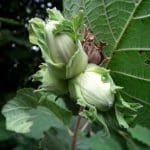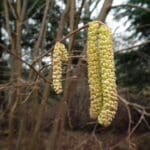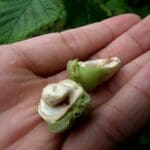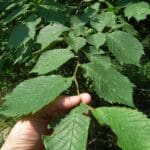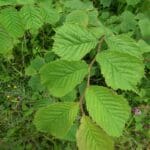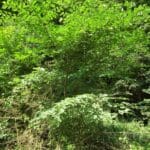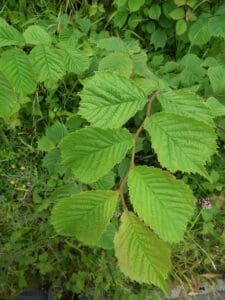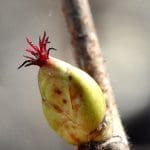Hazel / Spring / Summer / Autumn / Winter / Edible
Common Names
Hazel
Botanical Name
Corylus avellana
Scientific Classification
Kingdom – Plantae
Order –Fagales
Family – Betulaceae
Physical Characteristics for Hazel
The Common Hazel is typically found as a shrub reaching 2-8m tall where it’s coppiced, however when it’s left to grow un-coppiced it can reach 15m tall. The bark is grey brown, becoming darker with age and eventually becoming slightly peeling, the fresh young shoots are hairy.
Leaves
The leaves 6-12cm long and across, are rounded with a double serrated margin and hairs on both sides.
Flowers
The Flowers are formed in early spring before the leaves. The catkins come in two forms, male and female, male 5-12cm long are pale yellow whilst 1-3mm long, bright red, form mostly concealed in the buds.
Fruit
The 15-20mm spherical, yellow-brown, nut comes in a short leafed husk, in clusters of 1-5 together and will fall to the ground when ripe, September – October.
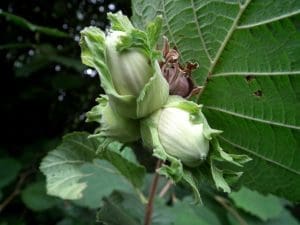
Habitat
Found growing on calcareous soils often in hedgerows and woodlands where it is used for hedging or coppicing.
Known Hazards
None know
Could be Confused with
Other species in the Corylus family, of which are similarly used. Linden Tree (Tilia) which has a similar leaf structure but the leaves are smoother and shoots are not hairy. It also grows to a huge size, doesn’t produce catkins or nuts and isn’t poisonous. Elm and Wych-Elm also have similar looking leaves, but they are rougher in texture, and again they don’t produce catkins or nuts.
Edible Uses
Leaves: green tea, fermented tea, dried tea, wine, smoking foods
Catkin: edible
Green nut: Salads, pasta, feta parcels, milk
Ripe nut: salads, pasta, cakes, pesto, flour, roasted, pickled, salted, soups, milk, oil
Notes on Herbal uses
The oil of Hazel is referenced as being used to treat infection of threadworm or pinworm in young children.
Extra notes from the Foragers
You have to get out early to collect these nuts before the squirrels get them, find a spot where you know they are and return weekly when you expect them to come in to season around early September, alternatively they can be pickled straight from the tree and used fresh. One of the few nuts that taste brilliant straight off the tree like this.
Although we only have one recipe in this book including Hazel I have included it above all other nuts producing trees as it produces the one wild nut I pick on a regular basis (when they’re green and can beat the squirrels to them). I then use this nut in any recipe that calls for either fresh or crushed nuts of any kind.
Hazel has a strong link in Celtic mythology with poets, literature and gaining wisdom.




